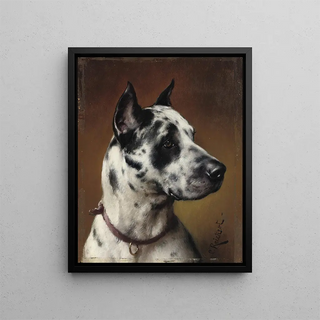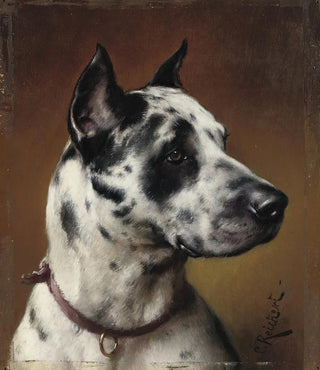Art print | A Great Dane - Carl Reichert


View from behind

Frame (optional)
In the vast panorama of art history, certain works stand out for their ability to capture the very essence of their subject. "Un grand danois - Carl Reichert" falls into this category, offering a striking representation of canine beauty. This piece, which evokes the majesty and nobility of this breed, transports the viewer into a universe where nature and art meet harmoniously. Contemplating this painting, one feels a deep connection with the animal, as if Reichert had succeeded in capturing not only the physical appearance of the Great Dane but also its soul.
Style and uniqueness of the work
Carl Reichert's style is characterized by remarkable finesse in rendering details. Every brushstroke seems to have been applied with surgical precision, allowing the texture of the dog's coat to be almost tactile. The subtly graded color nuances bring the work to life, creating a play of light that emphasizes the animal's presence. The backgrounds, often stripped down, highlight the main subject, thus enhancing the impression of grandeur emanating from the Great Dane. Furthermore, the majestic posture of the animal, lying down with natural grace, evokes a serenity that invites contemplation. This painting does not merely depict a dog; it makes it a symbol of loyalty and nobility.
The artist and his influence
Carl Reichert, an Austrian-born painter, is renowned for his animal portraits that transcend simple representation. His passion for animals and undeniable talent allowed him to build a solid reputation in the art world. Influenced by the great masters of his time, Reichert developed a style that is uniquely his own, blending realism and romanticism. His works, often imbued with a certain melancholy, testify to a deep understanding of animal psychology. By highlighting the beauty and dignity of animals, Reichert contributed to a redefinition of animal painting, placing it on a pedestal alongside human portraits. His legacy endures in the way contemporary artists approach the animal theme, seeking to establish a dialogue

Matte finish

View from behind

Frame (optional)
In the vast panorama of art history, certain works stand out for their ability to capture the very essence of their subject. "Un grand danois - Carl Reichert" falls into this category, offering a striking representation of canine beauty. This piece, which evokes the majesty and nobility of this breed, transports the viewer into a universe where nature and art meet harmoniously. Contemplating this painting, one feels a deep connection with the animal, as if Reichert had succeeded in capturing not only the physical appearance of the Great Dane but also its soul.
Style and uniqueness of the work
Carl Reichert's style is characterized by remarkable finesse in rendering details. Every brushstroke seems to have been applied with surgical precision, allowing the texture of the dog's coat to be almost tactile. The subtly graded color nuances bring the work to life, creating a play of light that emphasizes the animal's presence. The backgrounds, often stripped down, highlight the main subject, thus enhancing the impression of grandeur emanating from the Great Dane. Furthermore, the majestic posture of the animal, lying down with natural grace, evokes a serenity that invites contemplation. This painting does not merely depict a dog; it makes it a symbol of loyalty and nobility.
The artist and his influence
Carl Reichert, an Austrian-born painter, is renowned for his animal portraits that transcend simple representation. His passion for animals and undeniable talent allowed him to build a solid reputation in the art world. Influenced by the great masters of his time, Reichert developed a style that is uniquely his own, blending realism and romanticism. His works, often imbued with a certain melancholy, testify to a deep understanding of animal psychology. By highlighting the beauty and dignity of animals, Reichert contributed to a redefinition of animal painting, placing it on a pedestal alongside human portraits. His legacy endures in the way contemporary artists approach the animal theme, seeking to establish a dialogue






